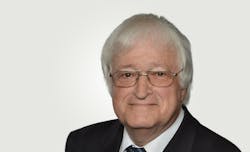OPC UA is a vendor-independent communication protocol designed for industrial use. Time-Sensitive Networking (TSN) is a further development of the IEEE Ethernet standards. Together, they aim to offer the first truly vendor-independent real-time, deterministic Ethernet communication standard. As the technologies receive increasing media attention, experts in the automation arena are asking: Will OPC UA TSN supersede existing industrial Ethernet networks?
A better industrial Ethernet?
It's widely believed that the market will decide whether OPC UA TSN will replace existing industrial Ethernet fieldbuses. But this raises the question: Who are the market participants and why would they switch from industrial Ethernet to OPC UA TSN?
In automation, there are three types of market participants: suppliers of automation and drives equipment, machine builders for factory automation and equipment suppliers for the process industries, and end users. The automation suppliers that developed today’s variety of industrial Ethernet fieldbuses began their developments by seeking to implement a standard protocol. But when it came to time-critical applications like high-speed motion control using servo drives, they developed the solution beyond standard Ethernet and often made hardware modifications to automation and drive devices to achieve the required reliability and robust, real-time performance. Furthermore, these suppliers often followed a proprietary strategy, adding to the burden of machine builders that were forced to adhere to the differing requirements of their end users. Dealing with many different fieldbus protocols turned out to be a real problem, even with the various groups of suppliers supporting certain “standards” like Profinet, EtherNet/IP, Sercos, Powerlink, EtherCAT and CC-Link IE.
Automation suppliers must follow major trends, thus will almost certainly implement OPC UA TSN Ethernet-based protocols. However, because of the huge investments and the large installed base of the existing industrial Ethernet fieldbuses, these systems will remain in place for many years to come. We expect that automation suppliers offering fast servo drive applications will test whether OPC UA TSN fulfills today’s requirements for hard real-time servo drive applications. These include requirements for safety, robustness, maximum cable length, and number of connectable drives. Once OPC UA TSN has been tested successfully and safety features are approved by the appropriate authorities, implementation will take place in parallel with the development of new series of devices—an incremental and evolutionary process that will follow the pace of acceptance.
Machine builders for discrete automation and suppliers of process automation equipment are in somewhat different positions in respect to OPC UA TSN.
Discrete automation market drivers
Machine builders typically focus on machine functionality (e.g., fast machine reaction times). If we view a production machine as a functional island and consider the current lack of automation and drive offerings with OPC UA TSN, it’s clear that machine builders have little if any reason to rush into replacing their current industrial Ethernet-based fieldbus systems.
To meet the data communication requirements of the Industrial Internet of Things (IIoT)/Industry 4.0 and deliver data from the machine to an upstream IT architecture, machine builders are adding new sensors and extracting more data from controllers and drives, and delivering these data to the IT network via gateway or edge computer. Ultimately, this could be accomplished via an OPC UA TSN interface built into the programmable logic controller (PLC) or industrial PC. Using a standard protocol to achieve interoperability would help reduce engineering costs to a significant degree.
Process automation market drivers
Equipment providers for process automation supply a market that includes large end-user organizations such as BASF, Bayer, Dow Chemical, ExxonMobil and Shell. Compared to the discrete automation market, the number of suppliers of distributed control systems (DCSs) and process automation sensors and actuators is much smaller.
Both the process and discrete manufacturing industries need real-time performance, but “real time” in these industries has different meanings, with more demanding performance requirements in discrete machine control. In the process industries, though performance requirements are not quite as demanding, 24/7 availability and high bandwidth are needed for nonstop, round-the-clock operation and to collect and analyze large amounts of process data.
Considering that the process industries never really had a process fieldbus solution with adequate bandwidth, the technical package offering by OPC UA TSN over Ethernet should be extremely attractive to process users, although it’s likely that many will be slow to adopt.
End-user drivers
End users would benefit the most from a seamless, common Ethernet protocol based on industry standards. The extreme variety of today’s industrial fieldbuses requires a costly, customized communication network to collect and transfer data to upstream IT equipment. By adding OPC UA TSN as a bridge between fieldbus islands, users could make installations interoperable at a modest cost.
Not the only game in town
OPC UA TSN is not the only technology threatening to displace existing industrial Ethernet protocols. The Object Management Group’s (OMG) Data Distribution Standard (also enhanced by TSN) is widely applied in defense, healthcare machine connectivity and energy infrastructure (particularly in North America), but also extends into robotics and machine building. The OPC Foundation, FieldComm Group and OMG are collaborating to establish DDS and OPC UA interoperability. Automation suppliers with worldwide sales will likely have to offer both communication standards in the future, either as two different protocols or as one communication software package if the OMG-OPC interoperability results in a seamless, easy solution that can be configured to be compatible with either DDS or OPC.
>>Frank Thomas is an associated senior consultant with ARC Advisory Group. As a freelancer, he supports ARC clients with technology and strategic research and consulting services to help them face today’s challenges and develop successful operations. Prior to joining ARC, he was vice president of automation in three different machinery companies, served as managing director of Eberle Automation and successors, as vice president of strategy at the motion control business of Siemens, and manager of strategy at Wittenstein.

